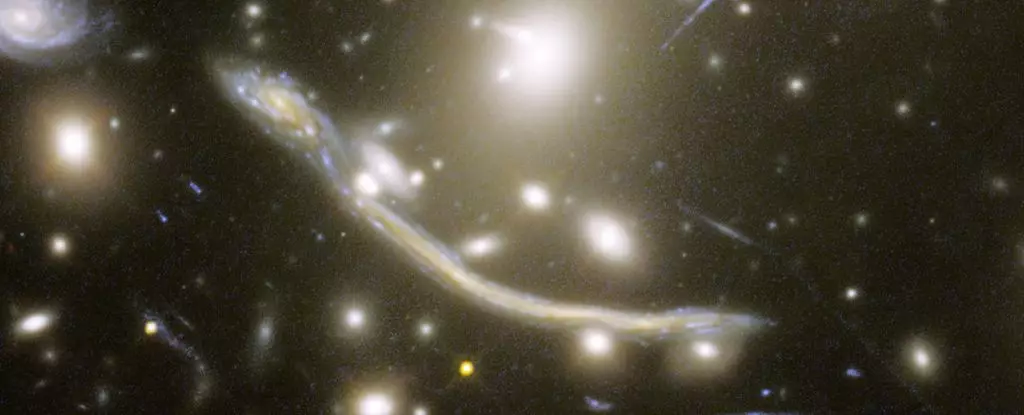The exploration of the cosmos has consistently pushed the boundaries of human understanding, and recent advancements in technology have opened new windows to the early Universe. The James Webb Space Telescope (JWST) represents a significant leap in our observational capabilities, allowing astronomers to peer deeper into the cosmos than ever before. This revolutionary instrument not only magnifies distant light but also enhances our ability to differentiate individual stars in galaxies that are billions of light-years away, transforming our understanding of the Universe and its evolution.
The vastness of space presents both challenges and opportunities for astronomers. The light arriving from these ancient celestial bodies has traveled for eons, often arriving as a blur of indistinguishable points. However, JWST has made it possible to distinguish over 40 individual stars on the fringes of a cosmic galaxy, with light having traveled nearly 6.5 billion years to reach us. According to astrophysicist Fengwu Sun from the University of Arizona, this leap is unprecedented: “While previous studies with the Hubble Space Telescope found around seven stars, we now have the capability to resolve stars that were previously beyond our reach.”
One of the critical methodologies that have facilitated these remarkable findings is gravitational lensing, a phenomenon predicted by Albert Einstein’s theory of general relativity. Large masses, such as galaxy clusters, create significant gravitational fields that warp the fabric of space-time around them. This effect can magnify and distort the light from objects situated behind these massive bodies, creating an effect often likened to viewing distant objects through a warped lens.
The Dragon Arc, a mesmerizing arc of light reminiscent of its namesake, is a prime example of this phenomenon. It consists of multiple images of the same distant spiral galaxy, shining brightly despite the immense distances involved. Researchers have utilized the characteristics of gravitational lensing not merely to observe distant light but to decrypt the structural makeup of the Universe and enhance our understanding of its origins.
The Abell 370 galaxy cluster, situated approximately 4 billion light-years away, serves as the gravitational powerhouse behind the Dragon Arc. By studying the intricate lensing effects of this galaxy cluster, astronomers can attempt to reconstruct what the background galaxies would appear like if the space-time warping was not present—albeit with the added benefit of magnification.
Adding another layer to this intricate celestial puzzle is the concept of microlensing, where individual stars, often roaming alone amidst a galaxy cluster, provide additional lensing effects. In a groundbreaking study led by astronomer Yoshinobu Fudamoto from Chiba University, a team harnessed microlensing to successfully discern 44 individual stars amidst the distorted light of the Dragon Arc.
The discovery is of monumental importance, not only because it allowed for the first imaging of such a large number of distant stars but also because it reveals pivotal insights into stellar evolution in galaxies far from our own. Notably, many of the stars identified in this research are classified as red supergiants. These colossal stars, nearing the end of their life cycles, exhibit a distinctive hue that sets them apart from their hotter, bluer counterparts. Since these cooler stars are generally more difficult to observe, the capability of JWST to detect red light has proven advantageous in this quest.
The implications of JWST’s discoveries are profound, not just for astronomy but for our broader understanding of the Universe’s history and chemistry. The ability to resolve and analyze individual stars offers researchers the chance to better understand dark matter, star formation, and galactic dynamics across the ages.
Future observations with the JWST are expected to reveal even more hidden stellar treasures within the blurry veil of the Dragon Arc. This unfolding story may illuminate the processes that govern galaxy evolution, enabling us to trace the lineage of stars and galaxies back to the rudimentary seeds of the Universe. As we venture further into this cosmic frontier, each new discovery could potentially reshape our understanding of our place within the vast, ever-expanding Universe.
In summation, the James Webb Space Telescope has not merely enhanced our observational capabilities; it has condensed the vastness of time and space into comprehensible fragments, allowing us to explore the genesis of stars and the evolution of galaxies. The exploration of cosmic mysteries remains an exciting endeavor, and as we continue to unlock its secrets, we simultaneously unearth our own origin within the fabric of space and time.


Leave a Reply